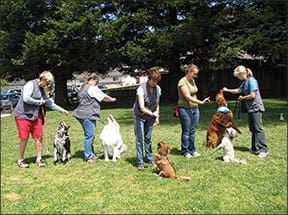High-five. Fetch. Jump through a hoop. Spin, twirl, and take a bow. There is no doubt that tricks are fun to train, and even more fun to show off to friends and family. But they are so much more than just a good time! Here are five things tricks can do for you, your dog, and your training.

1. Tricks build relationships.
When we sit on the floor and teach our pups to chase after a toy and bring it back, we are training a fun and useful trick. Perhaps more importantly, we are also engaging in one of the prime human-dog bonding behaviors—play! When we have fun with our dogs, our bond grows.
Certain tricks can also help you and your dog feel more comfortable with each other. Tricks where dogs interact with our bodies, such as leg weaves, help them learn to watch for our feet (especially good for smaller dogs), and to tolerate things people do to invade dogs’ “space,” such as stepping over them.
2. Teaching tricks lets the trainer hone her skills.
Teaching tricks helps people practice important training skills with less stress. It’s easy to forgive errors when you are teaching a just-for-fun trick, such as roll over or play possum. You can learn from your mistakes, and then apply what you’ve learned to other behaviors that may be more critical in day-to-day life.
Training with tricks also gives you the opportunity to try different techniques. Because it’s easier to teach some tricks through “shaping,” and to teach others with a lure of a treat or toy, and still others with gentle prompts, training tricks can help you experiment with a variety of ways to jump-start behaviors.
3. Tricks are a great way to help a dog learn the training game.
Training is essentially a game we play with our dogs. The end result of the game is to help them learn to respond to certain cues. Like any game, training has its own set of rules. Some of those rules are fairly obvious: The dog needs to pay attention; the person needs to keep the dog’s attention; a click or yes means a treat is coming. But some are a little more subtle: when the handler is “shaping,” the dog gets to try out different things; when the handler plays the lure and reward game, the dog’s nose should follow the treat.
Training tricks can also help a dog to learn an individual handler’s communication style and signals. Since we all have different ways of communicating – we use different tones, words, body language, and expressions – “just for fun” trick training builds the dog’s familiarity with the handler’s nuances. It may also help the handler learn to communicat more clearly with her dog.
4. Tricks can signal the dog that it’s time to relax and have fun.
For dogs, trick training is often enjoyable and even relaxing. Just the act of doing tricks can shift a dog’s emotional state from tense to relaxed. You can use the emotions created by tricks in a variety of situations. For example, if you have a dog who is nervous about vet visits, you can practice tricks while you wait in the reception area and exam room as a way to help your dog remain calm and happy.
Specific tricks can also be a helpful way to encourage a specific mental state. For example, take a dog who is uncomfortable with other dogs. If the dog knows a play bow, you can ask the dog to do that trick in the presence of other dogs, say at a dog class (where everyone is on leash and at a safe distance). Your dog may relax a little more because he is doing a trick. Other dogs may view the play bow as a friendly gesture and may respond accordingly. As the other dogs respond in a friendly manner, your dog may relax even more, similar to how a smile begets a smile in other humans.
5. Tricks can be used to build important skills.
Tricks can be the foundation for other behaviors. For example, once your dog knows that hand targeting (bumping his nose into your hand) is fun and earns rewards, you can use that trick to prompt other behaviors such as return to heel and to stand from a down.
Tricks can also help a dog learn to accept things she is not always happy about. Paw tricks like “shake” can help a dog become accustomed to paw handling. This may help a dog learn to accept checking between toes for foxtails or even nail clipping.
Some tricks have their own very practical applications. For example retrieves can be channeled into a dog fetching the newspaper in the morning or bringing your slippers in the evening.
Tricks can also be an outlet for exuberant dogs. High energy or over-excited dogs are often required to be calm and contain themselves. Tricks, such as skipping, spinning, and jumping can give active dogs an energy release and a structured way to be a little wild and expressive, without getting into trouble.
Trick training offers both the dog and handler a lot more than just fun. Of course, entertainment value alone is enough for tricks; they really are just a great way to spend time, have fun and play with your dog!
Mardi Richmond, MA, CPDT-KA, writer, dog enthusiast, and trainer, lives in Santa Cruz, CA, with her partner and a wonderful heeler-mix named Chance.






